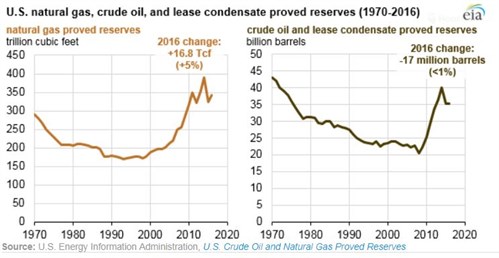U.S. proved reserves of natural gas up in 2016, oil reserves remained unchanged
The United States had 341.1 Tcf of natural gas proved reserves as of the end of 2016, an increase of 5% from 2015, according to EIA’s recently released U.S. Crude Oil and Natural Gas Proved Reserves report. U.S. crude oil and lease condensate proved reserves remained virtually unchanged from their 2015 level, at 35.2 billion barrels.
 |
| EIA’s recently released U.S. Crude Oil and Natural Gas Proved Reserves report. |
Proved reserves are those volumes of oil and natural gas that geological and engineering data demonstrate with reasonable certainty to be recoverable in future years from known reservoirs under existing economic and operating conditions. Changes in proved reserves from year to year reflect new discoveries, either in new fields, new reservoirs in old fields, or extensions of existing reservoirs; net revisions and other adjustments to previous reserve estimates; and reductions from annual production of each fuel.
Pennsylvania had the largest net increase in natural gas proved reserves of all states between 2015 and 2016, adding 6.1 Tcf of natural gas proved reserves in the Marcellus Shale play in the Appalachian Basin. Following a record high set in 2015, U.S. production of natural gas decreased 1% between 2015 and 2016—the first annual decline in U.S. natural gas production in 10 years.
The share of natural gas proved reserves from shale compared with total natural gas increased from 54% to 62% in 2016 because gas reserves were added in several shales, including the Wolfcamp, Marcellus, Eagle Ford, Utica, Woodford, and Haynesville shales.
Texas had the largest net increase in proved reserves of crude oil and lease condensate of all states between 2015 and 2016, adding 941 million barrels of proved crude oil and lease condensate reserves, mostly from development in the Permian Basin. Operators drilled and completed long horizontal wells into the stacked oil-bearing formations of the Spraberry Trend and the Wolfcamp Shale. Between 2015 and 2016, U.S. production of crude oil and lease condensate decreased by 6%.
More information about changes in proved reserves of natural gas, crude oil, and lease condensate is available in EIA’s U.S. Crude Oil and Natural Gas Proved Reserves, Year-end 2016 report.

- ExxonMobil halts 1-Bft3d blue hydrogen project in Texas
- Aramco and Yokogawa commission multiple autonomous control AI agents at Fadhili gas plant
- Ukraine will resume gas imports via Transbalkan route in November
- Mitsubishi to inject $260 MM into Brunei LNG project
- Freeport LNG (U.S.) on track to take in more natgas on Thursday after unit outage



Comments